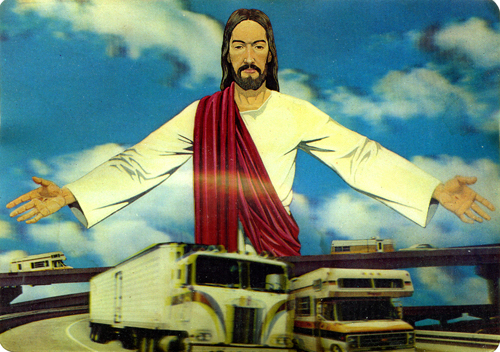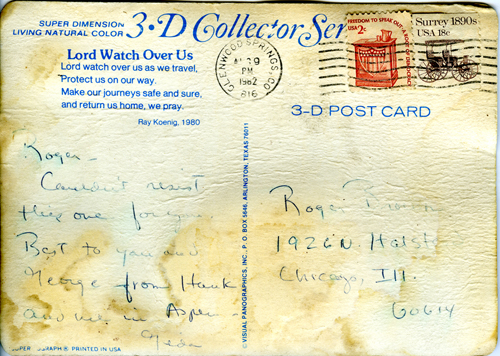The SUPER DIMENSION LIVING NATURAL COLOR 3·D COLLECTOR POSTCARD
Wednesday, February 9th, 2011 » By James Connolly » See more posts from STAFF PICS

The SUPER DIMENSION LIVING NATURAL COLOR 3·D COLLECTOR POSTCARD of a stoic Jesus Christ watching over cars on a highway caught my eye on my first visit to the Roger Brown Study Collection in 2004. Installed near Brown’s kitchen sink in what seems to be a Christian-ephemera-themed corner, the object is placed in close proximity to a shiny JESUS IS LOVE decal and an image of a Last Supper painting reproduced on a mirror. Never having been religious myself, the thing that caused the object to jump out at me wasn’t its ability to channel any type of Christian content, but rather its pure and unrepentant distillation of the Christ-figure into a product of Americana imagination and spectacle. The absurd juxtaposition of a highway overpass, a comic-book-like robed Son of God, and 70s-era trailers and trucks—all in 3d—is a perfect example of the strange materialization religion often takes on in the world of mass-produced collectibles and popular culture.
Versions of this postcard were mailed to Roger Brown at least twice, once by his aunt Gida in 1982 and again by Gilda Buchbinder in 1987. The fact that it was recognized as being in Brown’s taste by his friends (which is confirmed by his own placement of it among his most prized possessions in his Chicago collection) makes sense considering the religious upbringing that informed his art making and collecting practices. Brown stated in a 1993 interview with Kristine McKenna for the Los Angeles Times that “the church had a lot to do with shaping the weird way I see things, and though intellectually I’ve rejected those beliefs, you can never really get rid of that kind of childhood programming.” Though Brown socially and politically broke from religion, the nostalgic nature of his collecting and art-making alongside childhood memories transformed Christianity into a very personal category for him, appearing in his work having been filtered through his own extraordinary aesthetic.
-James Connolly


